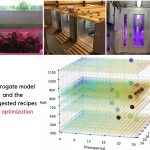Plant Science Research Weekly: April 12th
Review: Copy Number Variations shaping plant domestication
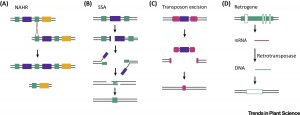 Human-associated plant domestication is a co-evolutionary process that began at least 12,000 years ago. However, the genetic variations underlying many domestication traits are still unknown. In this review, Lye and Purugganan discuss how copy number variations (CNVs) have played an important role in plant and animal domestication. CNVs are deletions, duplications or amplifications (usually at least 1 kb long) that can occur in both coding and noncoding genomic regions. Genetic mechanisms such as unequal cross over, DNA double-strand break repair and transposon activity – all of these can give rise to CNVs. While deletion CNVs are often associated with domestication traits, gene amplifications are more common in CNVs linked to diversification traits and environmental adaptation. Understanding the role of CNVs in the evolution of domestication traits can thus provide useful resources for crop improvement. (Summary by Saima Shahid) Trends in Plant Sci. 10.1016/j.tplants.2019.01.003.
Human-associated plant domestication is a co-evolutionary process that began at least 12,000 years ago. However, the genetic variations underlying many domestication traits are still unknown. In this review, Lye and Purugganan discuss how copy number variations (CNVs) have played an important role in plant and animal domestication. CNVs are deletions, duplications or amplifications (usually at least 1 kb long) that can occur in both coding and noncoding genomic regions. Genetic mechanisms such as unequal cross over, DNA double-strand break repair and transposon activity – all of these can give rise to CNVs. While deletion CNVs are often associated with domestication traits, gene amplifications are more common in CNVs linked to diversification traits and environmental adaptation. Understanding the role of CNVs in the evolution of domestication traits can thus provide useful resources for crop improvement. (Summary by Saima Shahid) Trends in Plant Sci. 10.1016/j.tplants.2019.01.003.
Review: Connecting the pieces: uncovering the molecular basis for long-distance communication through plant grafting
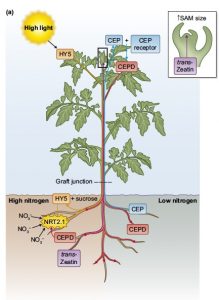
Grafting is an ancient vegetative asexual plant propagation technique. It is characterized by the connection of two plant segments, the shoot piece known as ‘scion’ and the root piece called ‘rootstock’ or simply ‘stock’. Grafting is widely used in agriculture to improve crop production and provide tolerance to biotic and abiotic stress. Beyond its use in horticultural production, it has received great prominence as an important tool in biological research, mainly regarding signalling mechanisms related to root-shoot communication. In this review, Thomas and Frank highlight how plant grafting has facilitated the discovery of new long-distance signalling molecules that coordinate root–shoot growth responses to drought stress, light and nitrogen availability. Plant vascular systems may serve not only as conduits for the translocation of essential substances but also as long-distance communication pathways that allow plants to adapt to changes in internal and external environments at the whole plant level. (Summarized by Francesca Resentini) New Phytol. 10.1111/nph.15772
Dramatic changes in repeat element content and gene family sizes underlie the high-altitude adaptation of rock-cress
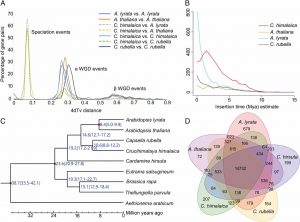 The ability to grow on the ‘roof of the world’ – the Qinghai-Tibet Plateau, makes Crucihimalaya himalaica (Rock-cress) an important model for studying adaptive evolution. A draft genome sequence of C. himalaica reported by Zhang et al. now provides clues to its speciation and ecological adaptation. About 45% of C. himalaica genome consists of transposable elements (TEs), which is ~1.5 times more than its close relative, Arabidopsis thaliana. Most of these TEs are LTR retrotransposons, whose proliferation coincides with the rapid elevation of the Qinghai-Tibet Plateau ~2 Mya. The authors concluded that expansion of LTRs, ubiquitin system- and DNA repair-related gene families, and reduction of disease and immune response-related gene families likely contributed to the adaption of C. himalaica to the strong UV radiation, low-pathogen and high altitude environment of the Himalayas. (Summary by Saima Shahid) PNAS 10.1073/pnas.1817580116.
The ability to grow on the ‘roof of the world’ – the Qinghai-Tibet Plateau, makes Crucihimalaya himalaica (Rock-cress) an important model for studying adaptive evolution. A draft genome sequence of C. himalaica reported by Zhang et al. now provides clues to its speciation and ecological adaptation. About 45% of C. himalaica genome consists of transposable elements (TEs), which is ~1.5 times more than its close relative, Arabidopsis thaliana. Most of these TEs are LTR retrotransposons, whose proliferation coincides with the rapid elevation of the Qinghai-Tibet Plateau ~2 Mya. The authors concluded that expansion of LTRs, ubiquitin system- and DNA repair-related gene families, and reduction of disease and immune response-related gene families likely contributed to the adaption of C. himalaica to the strong UV radiation, low-pathogen and high altitude environment of the Himalayas. (Summary by Saima Shahid) PNAS 10.1073/pnas.1817580116.
Diverse metabolites across maize GWAS panel for dissecting maize genetic architecture
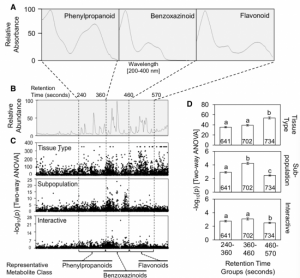 Plants can produce metabolites that are directly involved in various biological pathways. Identifying variations of specific metabolites in different genotypes would facilitate the understanding underlying complex genetic architecture of maize. One of most representative natural diversity panels, the 282 Goodman Diversity Panel, was used to perform LC-MS on tips and bases of leaves of each genotype. In total, 7,000 mass features survived after filtering. Based on the retention time, three major classes of metabolites were separated, phenylpropanoids, benzoxazinoid-like and flavonoid-like. Using these metabolites, GWAS results show that the majority of metabolites were significantly associated with genomic loci. This massive information from the metabolomic side can serve as a valuable resource for bridging the gap between genotype and phenotype, which provides an opportunity to explain phenotypic variants. (Summary by Zhikai Liang) Plant Cell 10.1105/tpc.18.00772
Plants can produce metabolites that are directly involved in various biological pathways. Identifying variations of specific metabolites in different genotypes would facilitate the understanding underlying complex genetic architecture of maize. One of most representative natural diversity panels, the 282 Goodman Diversity Panel, was used to perform LC-MS on tips and bases of leaves of each genotype. In total, 7,000 mass features survived after filtering. Based on the retention time, three major classes of metabolites were separated, phenylpropanoids, benzoxazinoid-like and flavonoid-like. Using these metabolites, GWAS results show that the majority of metabolites were significantly associated with genomic loci. This massive information from the metabolomic side can serve as a valuable resource for bridging the gap between genotype and phenotype, which provides an opportunity to explain phenotypic variants. (Summary by Zhikai Liang) Plant Cell 10.1105/tpc.18.00772
Injured plants induce the processing of immunomodulatory peptides in a Ca2+-dependent manner ($)
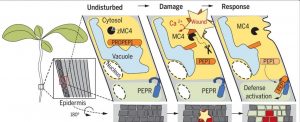 Plants are sessile organisms that have evolved an extraordinary immune system to optimally adapt to the risky environment, which includes hazards such as insect chewing, weather damaging, and pathogen invasion. But the signaling mechanism of how the physical damage of cells triggers the intracellular defense response remains to be elucidated. Recently Hander el al. demonstrated that physical damage of plant cells led to the loss of cell-membrane integrity, inducing the influx of extracellular Ca2+ into the cytosol. Intracellular Ca2+ instantly and spatiotemporally activated the cytosol-localized matacaspases such as MC4, which in turn cleaved and released wound-immunomodulatory peptides including PEP1 from its precursors. PEP1 binds its classic receptor PEPRs to induce innate immunity-like response. This discovery reveals a more detailed mechanism of PEPRs related defense-response, and also shows us the potential targets to improve disease resistance of high-performance crop varieties. (Summary by Nanxun Qin). Science 10.1126/science.aar7486
Plants are sessile organisms that have evolved an extraordinary immune system to optimally adapt to the risky environment, which includes hazards such as insect chewing, weather damaging, and pathogen invasion. But the signaling mechanism of how the physical damage of cells triggers the intracellular defense response remains to be elucidated. Recently Hander el al. demonstrated that physical damage of plant cells led to the loss of cell-membrane integrity, inducing the influx of extracellular Ca2+ into the cytosol. Intracellular Ca2+ instantly and spatiotemporally activated the cytosol-localized matacaspases such as MC4, which in turn cleaved and released wound-immunomodulatory peptides including PEP1 from its precursors. PEP1 binds its classic receptor PEPRs to induce innate immunity-like response. This discovery reveals a more detailed mechanism of PEPRs related defense-response, and also shows us the potential targets to improve disease resistance of high-performance crop varieties. (Summary by Nanxun Qin). Science 10.1126/science.aar7486
Moonlighting activities in phosphatases and the control of meristem maintenance in maize ($)
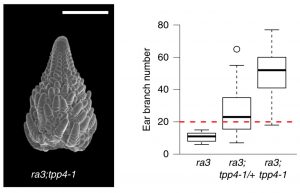 The phosphorylated disaccharide trehalose 6-phosphate (T6P) is a regulator of meristem fate. Mutations in enzymes related to T6P metabolism (such as TPS, the synthase, or the phosphatase trehalose 6-phosphate phosphatase TPP, i.e., RAMOSA3 that dephosphorylates T6P to trehalose), are linked to defects in reproductive development in maize. For instance the ramosa3 (ra3) mutant has increased tassel branching and ectopic branching in ears, due to reduced meristem determinacy. To better understand the role of TPP in the regulation of meristem determinacy, Claeys et al, identified TREHALOSE 6-PHOSPHATE PHOSPHATASE 4 (TPP4), a fully redundant paralogue of RA3. The T6P disaccharide levels are similar in the ra3, the ra3;tpp4-1 double mutant and the B73 wild type, so the authors speculate TPP4 enzymatic activity may not be important for the roles of those phosphsatases in meristem maintenance. Their EMS-generated tpp4 alleles were affected in ear branching, but the enzymatic activity of the different encoded TPP versions varied from 0 to 35% compared to the wild type. Additionally, the ra3 mutant could be complemented by a catalytically dead RA3. All these findings suggest a non-enzymatic function as responsible for the role of TPP in the control of meristem determinacy. The localization of RA3 in some nuclear compartments suggests a role in the regulation of RNA processing and transcription. Precise control of meristem activity, through these genes, could lead to higher yields in maize and other crops. (Summary by Humberto Herrera-Ubaldo) Nature Plants 10.1038/s41477-019-0394-z
The phosphorylated disaccharide trehalose 6-phosphate (T6P) is a regulator of meristem fate. Mutations in enzymes related to T6P metabolism (such as TPS, the synthase, or the phosphatase trehalose 6-phosphate phosphatase TPP, i.e., RAMOSA3 that dephosphorylates T6P to trehalose), are linked to defects in reproductive development in maize. For instance the ramosa3 (ra3) mutant has increased tassel branching and ectopic branching in ears, due to reduced meristem determinacy. To better understand the role of TPP in the regulation of meristem determinacy, Claeys et al, identified TREHALOSE 6-PHOSPHATE PHOSPHATASE 4 (TPP4), a fully redundant paralogue of RA3. The T6P disaccharide levels are similar in the ra3, the ra3;tpp4-1 double mutant and the B73 wild type, so the authors speculate TPP4 enzymatic activity may not be important for the roles of those phosphsatases in meristem maintenance. Their EMS-generated tpp4 alleles were affected in ear branching, but the enzymatic activity of the different encoded TPP versions varied from 0 to 35% compared to the wild type. Additionally, the ra3 mutant could be complemented by a catalytically dead RA3. All these findings suggest a non-enzymatic function as responsible for the role of TPP in the control of meristem determinacy. The localization of RA3 in some nuclear compartments suggests a role in the regulation of RNA processing and transcription. Precise control of meristem activity, through these genes, could lead to higher yields in maize and other crops. (Summary by Humberto Herrera-Ubaldo) Nature Plants 10.1038/s41477-019-0394-z
Flavor-cyber-agriculture: Optimization of plant metabolites in an open-source control environment through surrogate modeling
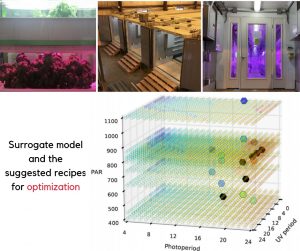 Cyber-agriculture is a computer-controlled plant growing environment which regulates climatic conditions through machine learning, finding optimized variables (“recipes”) to maximize a specific plant trait. Here, Johnson et al. applied cyber-agriculture to chemotype optimization for flavor in basil (Ocimum basilicum) through surrogate modeling. As light exposure has been shown to increase aromatic molecules concentration, the study variables were UV-B light period, photosynthetic-active radiation (PAR) values, and photoperiod. A chemscore was used as a target metric of flavor by using gas chromatography-mass spectrometry (GC-MS) for semiquantitative volatiles analysis. Symbolic regression iterations were made to build predictive surrogate models, which suggested long photoperiods and long UV periods. The recipes were tested in the Food Computer with a hydroponic configuration, resulting in improved flavor concentration, with plant mass losses. This demonstrates the “dilution effect”, the well-known mass yield/flavor tradeoff. Furthermore, this model helped to realize the dominating effect of photoperiod and the constant-daylight positive effect. Cyber- agriculture is a helpful technique that will change agriculture in the future as it is safe, it minimizes costs and is automatically built enabling faster plant quality upgrades. (Summary by Ana Valladares). PLOS One. 10.1371/journal.pone.0213918
Cyber-agriculture is a computer-controlled plant growing environment which regulates climatic conditions through machine learning, finding optimized variables (“recipes”) to maximize a specific plant trait. Here, Johnson et al. applied cyber-agriculture to chemotype optimization for flavor in basil (Ocimum basilicum) through surrogate modeling. As light exposure has been shown to increase aromatic molecules concentration, the study variables were UV-B light period, photosynthetic-active radiation (PAR) values, and photoperiod. A chemscore was used as a target metric of flavor by using gas chromatography-mass spectrometry (GC-MS) for semiquantitative volatiles analysis. Symbolic regression iterations were made to build predictive surrogate models, which suggested long photoperiods and long UV periods. The recipes were tested in the Food Computer with a hydroponic configuration, resulting in improved flavor concentration, with plant mass losses. This demonstrates the “dilution effect”, the well-known mass yield/flavor tradeoff. Furthermore, this model helped to realize the dominating effect of photoperiod and the constant-daylight positive effect. Cyber- agriculture is a helpful technique that will change agriculture in the future as it is safe, it minimizes costs and is automatically built enabling faster plant quality upgrades. (Summary by Ana Valladares). PLOS One. 10.1371/journal.pone.0213918



